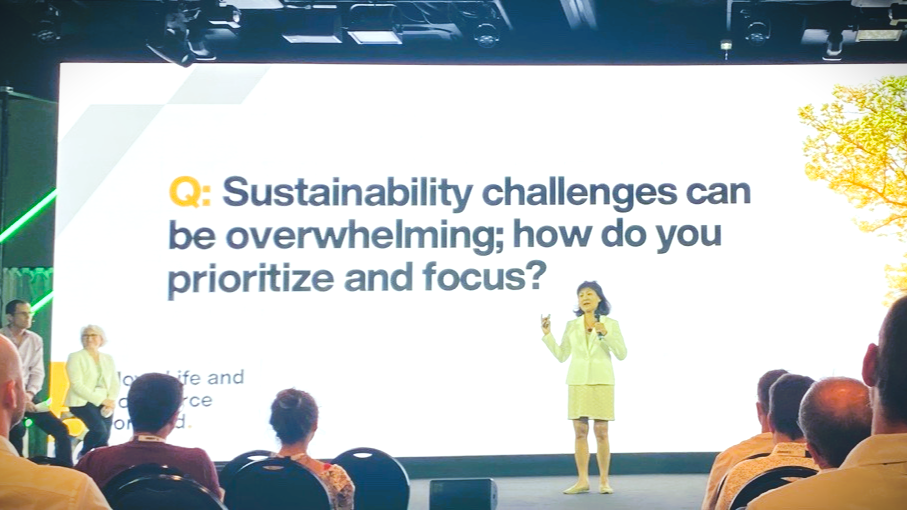Being bold on supply chain sustainability

|
Getting your Trinity Audio player ready...
|
From a consumer perspective, more than half of adults surveyed said they‘d prioritize environmental friendliness over quicker deliveries. And while some shoppers are switching to cheaper brands –as rising living costs influence behavior – it’s clear that price isn’t the only thing that retailers have to get right. Supply chain sustainability must go hand in hand with meeting the needs of future customers and the planet.
The findings are based on omnichannel research commissioned by Manhattan Associates, which sought out the views of 6,000 consumers from 12 countries across four continents. And for retailers wondering whether environmental credentials are nice to have, but not essential, the following observations note the direction of travel.
The report’s authors highlight that younger generations are more likely to pay close attention to a store’s sustainability efforts compared with older consumers. What’s more, 17% of the 24-35 age bracket said they would actively avoid brands viewed as not being environmentally conscious, compared with just 10% of over 55s.
There are implications here too in terms of recruitment as, in many cases, employees aspire to work for companies that they believe in. Firms that get ahead on supply chain sustainability may attract not just customers who are committed to the brand, but staff as well.

Ann Sung Ruckstuhl of Manhattan Associates on-stage at Exchange 2023 moderating a panel discussion on overcoming sustainability challenges, which featured Marcus LeMaster of Schneider Electric and Cécile Laroumanie of Bartle (both seated to the left of the big screen).
Plus, with supply chains representing a big chunk of carbon emissions for many firms, they are the ideal choice for making an impact on sustainability goals. For firms looking to prioritize and focus on supply chain sustainability, two case studies stand out in particular from Manhattan’s recent Exchange event, which took place in Cannes, France.
The supply chain experts sharing their thoughts during Tuesday afternoon’s session were Cécile Laroumanie, Partner at Bartle, and Marcus LeMaster, Global Director of Logistics Sustainability at Schneider Electric.
Supply chain sustainability case studies
Recognizing that supply chain sustainability is a team effort – involving customers too, as we’ll get to – not just the job of a single department, Schneider Electric makes progress a meaningful component of its employee bonus awards.
LeMaster reports that 30% fewer km are driven in getting goods from A to B thanks to improvements made in supply chain operations. And he emphasizes the importance of data in the decision-making process.
Schneider Electric announced in May 2023 that it had selected Sightness as its global platform for freight transport emissions analytics. Having the numbers to hand is indispensable for making the right call on supply chain sustainability. For example, on-shoring may sound like a step forward to some, but not if it means swapping low-carbon shipping for higher-emission road transport – a point made by LeMaster during the panel discussion.
“The world agrees that we need to transition to more sustainable energy systems. And we’ve been able to figure out how to make an awesome electric vehicle, or grid scale batteries, or the cells that go into them. But we’ve been pushing the supply chain challenges down the road.… pic.twitter.com/Bvx2s9Ufvb
— American Battery Technology Company (@abt_company) October 13, 2023
Laroumanie encouraged the audience to be bold on supply chain sustainability, and she had evidence to back up her words. Bartle has helped clients who were relying on a shorter lead time by airfreight to improve environmental performance by helping them adapt to a longer lead time by sea, without disruption to customers. Also, she forecasts that the circular economy will become a much bigger part of e-commerce.
Swapping airfreight for shipping and identifying opportunities for remanufacturing and reuse will improve balance sheets as well as help companies to achieve their environmental ambitions. “Sustainability can translate into cost savings when it comes to supply chains,” Sebastien Lefebure, Managing Director France & Southern Europe at Manhattan Associates, told TechHQ.
Supply chain management tools that unify warehouse management systems and transport management systems pave the way for so-called cubing. Here, joined-up supply chain data, together with optimization algorithms, help operators pack items more efficiently to transport more products and less air.
Better transport utilization improves supply chain sustainability as well as reducing operating costs. Also, it’s interesting to note that the importance of delivery times to customers may have been overestimated.
“It’s not speed, it’s certainty,” said Ann Sung Ruckstuhl, Senior Vice President and Chief Marketing Officer at Manhattan Associates, who joined the firm in 2021 and has a strong track record in building successful startups and transforming Fortune 500 companies.
Adding detail to the supply chain picture
Ruckstuhl was on-stage at Exchange 2023, moderating the panel discussion featuring Laroumanie and LeMaster in the main hall. She’s a firm believer in consumers’ ability to make rational decisions based on availability, price, delivery, and sustainability. And, if Ruckstuhl’s Silicon Valley-honed instincts are right, companies will be able to make great ground by adding more details – thanks to advances in supply chain management capabilities – so that clients can decide what’s right for them.
Today, it’s often the case that consumers don’t have visibility of the impact of their purchase choices. But suppliers can change that by working with solutions providers such as Manhattan Associates and others. On TechHQ we’ve written about how blockchain can provide a digital ledger to enable product passports as goods move along the supply chain.
There are other innovations too, such as self-powered Bluetooth sensors that are a promising way of supporting the circular economy. Naturally, mainstream technology, which includes RFID tags, has a major role to play as well. RFID tags push supplier inventory accuracy to new heights and can dramatically improve operations across all channels.

RFID tag inside a clothing label. Photo: JT
We’ve mentioned (in Five Ways to Improve Supply Chain Performance) how providing customers with more self-service options (step five) helps contact center teams focus on more complex queries. But engineering systems so that clients can change their minds right up until orders are picked also benefits reverse logistics by reducing product returns – a win for improving supply chain sustainability.
There are opportunities all around for companies to reduce their carbon footprint. For example, financial services isn’t a sector that many would consider as contributing major carbon emissions through its supply chain. But business travel is a big component of operations, and advances in virtual reality – including hardware, software, and professional avatars – could change that.
Wrapping up the panel discussion, Ruckstuhl asked attendees to pick one thing and start there, to focus their supply chain sustainability efforts, and it’s good advice – particularly if you can get customers involved too.









